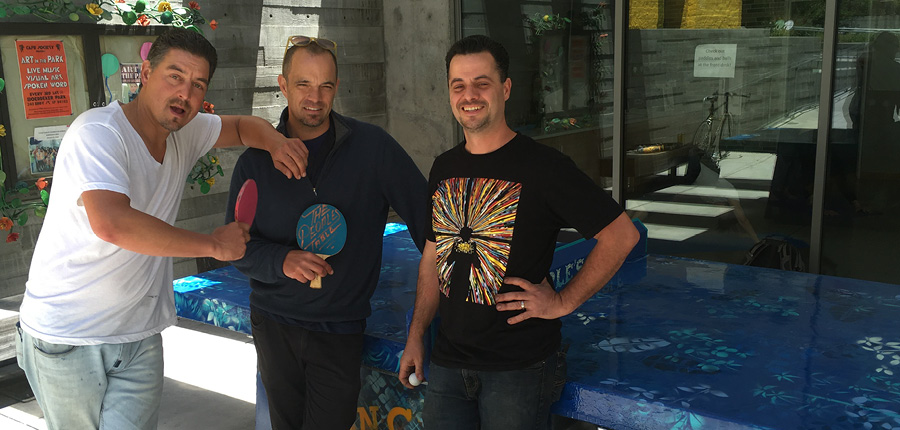This Student's on the Ball
Near the corner of Eddy and Jones in San Francisco’s Tenderloin neighborhood is the entrance to Boeddeker Park, a recently revamped public space with a basketball court, a swing set, an area for tai chi practitioners and a glass-walled clubhouse. And since February, the park has also featured an outdoor ping-pong table, a work of art in itself, completed by local artists and designers as part of "The People's Table" collaborative. The project manager and one of the founders, Galen Maloney, is pursuing a master’s degree in public health at SF State’s College of Health and Social Sciences. Maloney has been interested in finding ways to promote community engagement and play in outdoor public areas since spending time in Europe, where ping-pong tables can be found in cities like Barcelona and Berlin.

The table has inspired interactions between old and young, non-English speakers and native speakers and others who wouldn’t normally connect — which is the whole idea. Now, thanks to a $2,000 Albert Schweitzer Fellowship award, Maloney is moving ahead with another table, hopefully to be located somewhere along Market Street.
Maloney was recently selected to join the San Francisco Bay Area Albert Schweitzer Fellowship class of 2017. The program seeks to develop a pipeline of emerging professionals to give them the skills to address unmet health needs. Maloney says he’ll use the award to cover the cost of materials for the new table as well as the permit fees associated with installation.
According to Maloney, installing play objects like ping-pong tables, climbing walls or chess tables can change the dynamics of a community and can give people a chance to lower their stress levels.
“Tenderloin and Mid-Market are tough neighborhoods. You have a lot of mental health problems and drug addiction. Even if people are housed, a lot of times they’re living in single-room occupancy hotels,” he says. “So the public space is really limited. Ideally, we’re creating a space for people to interact, have a fun time and meet people. This isn’t going to be a political revolution. But it’s providing a space for people to come together.”
Rama Ali Kased, a lecturer in health education at SF State who is Maloney’s faculty adviser on the project, says Maloney has thought a lot about how to address the well-being of a community.
“He’s always looking around in public places, particularly in San Francisco, to see how space can be better used,” she said.
After graduating from SF State, Maloney hopes to continue working in urban design, public health and youth development.
“I want to help make cities and public space more accessible, more enjoyable and more beautiful — eventually more just,” he says.
Better Suited for Space

Of the 537 astronauts who have traveled to space, just 60 have been women. But an exploratory study done by SF State kinesiology graduate student Kaylie Marsh suggests that women might be able to maintain their health during prolonged spaceflights just as well as men.
Marsh’s study looked at how participants responded to exercises that combine cardio and strength training in simulated microgravity. She used muscle tissue samples taken in a previous study undertaken at California State University, Long Beach by a colleague of SF State Assistant Professor of Kinesiology Jimmy Bagley. In that study, eight men and eight women used crutches to get around and wore a shoe with a one-and-a-half inch sole. The other leg was left dangling for 10 days to simulate weightlessness. Marsh analyzed the muscle biopsies taken before and after the 10-day period.
“I was seeing all these differences with women responding differently than men,” she said. “At least in my study, some of the women’s muscle fibers were bigger in general than the men’s fibers, suggesting that gender made little difference at the cellular level in our participants.”
Marsh plans to submit her findings to the American College of Sports Medicine and hopes to publish the research by next year.
“If we’re doing these spaceflights to Mars that last six months, maybe we should be targeting females and encouraging them more to go into space because it might not affect their musculature as much as men,” she says.